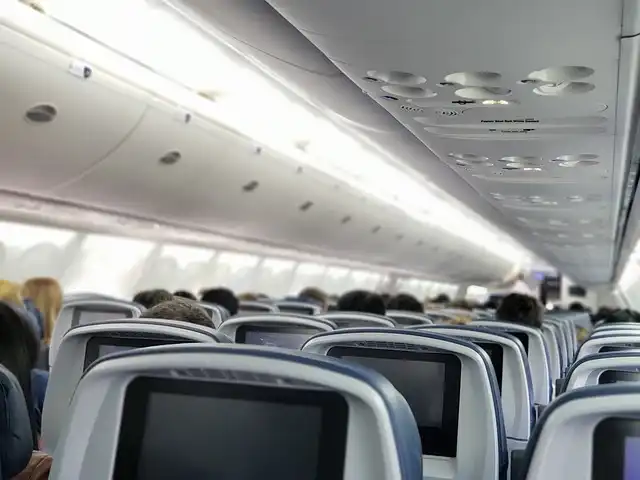Staggered Disembarkation: Airplane Safety, Psychology & New Rules

Explore staggered disembarkation's origins, safety concerns of early standing, and psychological factors driving passenger rush. New regulations and solutions for calmer, safer airplane exits are discussed.
Staggered disembarkation is another measure designed to prevent guests standing before the airplane prepares to be disembarked from. It was presented during the Covid-19 pandemic, with airline companies allowing sets of passengers to leave the aircraft at any once, in order to suppress the spread of the disease.
The Origins of Staggered Disembarkation
Owing to the success of the system at the time, numerous airlines and aerospace business have since been checking out means to motivate this method. For instance, Airplane claimed formerly that its engineers were working with an illumination system to advertise safe and comfortable off-boarding.
If you’re anything like me, the minute the plane has hit the seatbelt and the tarmac signs are off, you rush to your feet, step out right into the aisle and impatiently begin taking your cabin travel luggage out of the overhanging locker– also if the doors aren’t open and there’s no place for you to go.
“People high up on that scale have a tendency to be organised, self-displined and systematic. They can additionally endure temporary loss for longer-term gain, so they can delay satisfaction,” he discusses. “So, if they are in a scenario which needs patience, they will endure the temporary disappointment– understanding that longer-term gratification will occur.”
“To start with, with everybody standing in the aisles, they obstruct the sight for the crew that are needed to actively oversee and check the whole airplane and the airplane doors,” he says. “There is the added safety ramification that opening up overhead lockers while every person is standing can create injury. Things might have moved during landing, which can conveniently fall and hit a passenger.
Safety Risks of Premature Standing
Turkey is not just the 6th most-visited country worldwide, drawing in some 16 million tourists annually, but its front runner carrier, Turkish Airline companies, also runs virtually 400,000 flights each year and in 131 countries.
“The solution is a novel illumination design based upon basic web traffic assisting concepts: the scenario makes use of various cabin lighting combinations to suggest the rows which are assigned to disembark next. The lights circumstances match the verbal signs given by the cabin staff to promote a rush-free and organized departure from the airplane,” the press release read.
According to James Morgan *, cabin team for a prominent international airline, there are a variety of reasons that guests ought to prevent early disembarkation. He tells Condé Nast Visitor: “Standing as quickly as the seat belt indicators have been snuffed out is incredibly discouraging for various other travelers around them, that may not be able to stand as a result of their position on the airplane (i.e. a center seat occupier), and sometimes, the standing delay might be extensive while the air bridge or actions are attached and the aircraft doors securely opened up.”
From Morgan’s perspective, he believes fines are a “fantastic concept” that all aeronautics bodies throughout the world need to adopt, as it’s just a “much better, more tranquil and civilised way to disembark an aircraft, in an extremely regulated, risk-free and safe fashion.”
A current study by the College of Waterfront discovered that the main stressors when it comes to rashness are: how unpleasant the circumstance is; just how much you desire to accomplish something; the blameworthiness of others around you; and whether the hold-up in action is longer than you anticipated it would certainly be– though the size of the delay did not itself matter.
Turkey’s New Disembarkation Rules
In a proposal to clamp down on the variety of guests standing up prior to the aircraft has finished cabbing to the incurable, Turkey’s civil aviation authority has actually set out the brand-new procedure, which proposes that flyers stay seated– also when the seatbelt sign is off and the plane has actually come to a stop– up until it is their row’s turn to leave the aircraft.
Dickens confirms that who you are taking a trip with can modify the characteristics, acknowledging that those with dependents and kids, as an example, might feel stressed since their kids are crying or troubled.
Psychological Factors Behind the Rush
When it comes to handling rashness and stress and anxiety degrees, Dickens states there are individuality treatments we can take– and workouts such as controlled breathing, focusing on the longer-term gain, counting to 10 and diverting our interest to the positives of the circumstance can help.
Similarly, those taking a trip for business may be fretted about making a crucial meeting: “There’s an added degree of stress triggered by this, especially if you need to make clear the city and other people are relying on you. And if you fly routinely for company, you might get frustrated by individuals who are less experienced travellers than you, since they have a tendency to hold points up.”
In a similar way, some airline companies play music when you board and leave the aircraft to set the tone for the journey and tranquil nerves. There have actually been numerous researches for many years that have connected songs to stress management, with scientists at Stanford University specifying that “listening to music appears to be able to change brain working to the very same level as medicine.”
Solutions for a Calm Disembarkation
Dickens agrees that there are a variety of reasons for our rashness when it pertains to disembarking an airplane– or travelling through eviction at separations, for that matter– and it isn’t always as simple as having poor good manners or being rude of others (give thanks to benefits).
The 2nd concern, from a safety and security perspective, is hurrying and possible squashing, according to Morgan. He describes: “The aisles on all airplane are not specifically wide and with passengers rushing to get off, the threat of squashing is enhanced– as is the case whenever there are huge events of people.”
“From a protection factor of sight, the authorities, authorities, paramedics, migration, port health and wellness, and so on, might wish to get in the airplane to help a guest, arrest a traveler, and so on,” Morgan includes. Due to language obstacles, neurodiversity, wish to catch a limited attaching flight and so on, guests might still continue with standing and moving along the aisles when requested not to.”
“According to the guideline, airlines are required to advise guests to fasten their seatbelts throughout and after landing up until they reach the car parking position and to explicitly mention that any kind of violation will certainly be reported to the aeronautics authority, and a fine will certainly be enforced,” German information company DPA reported.
“From a security viewpoint, the authorities, police, paramedics, migration, port health, and so on, may wish to get in the airplane to aid a passenger, arrest a traveler, and more,” Morgan includes. “In these circumstances, we would typically make a [public address] either from the onboard management, captain, or both, requesting that guests need to continue to be in their seats. However, due to language obstacles, neurodiversity, need to catch a limited attaching flight and so on, passengers might still wage standing and relocating along the aisles when requested not to.”
Paul Dickens, club member of the British Psychological Culture and accredited air travel psycho therapist, tells Condé Nast Traveller that patience is linked to the individuality variable of conscientiousness.
“To start with, with everybody standing in the aisles, they obstruct the sight for the team who are needed to actively supervise and keep an eye on the entire aircraft and the airplane doors,” he states. “There is the included safety and security ramification that opening up overhead lockers while every person is standing might cause injury. Items may have moved throughout landing, which could easily drop and hit a guest.
“Furthermore, as guests thrill and take their things out of the lockers, there is a tighter pivot turning because of other guests standing either side of you in, allow’s encounter it, quite close closeness. This, once again, might lead to a guest being hit in the head or body with an item from the storage locker as it’s being manoeuvred out and to the floor.”
For me, personally, it isn’t a lot regarding my eagerness to begin my holiday as it is to leave a restricted, stale space. I am not keen on flying anyway, however my anxiousness is heightened if I have actually had a particularly rough trip, a long-haul journey, or I’ve obtained a link to make on the other side. Add to the mix the absence of a/c– which is normally switched off now– and I feel myself expanding a growing number of discombobulated by the minute, determined to get off.
1 airplane safety2 aviation psychology
3 flight stress
4 new rules
5 passenger behavior
6 staggered disembarkation
« Airline Pilot De-escalates Flight Situation with KindnessAAR: Expanding Air Connectivity in Europe & Beyond »
